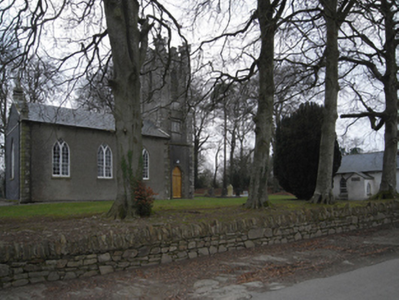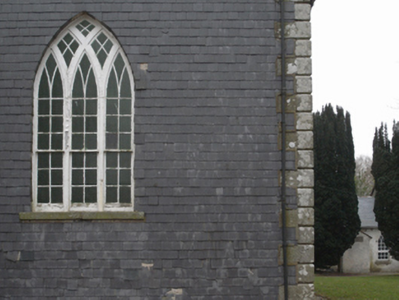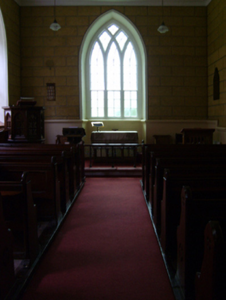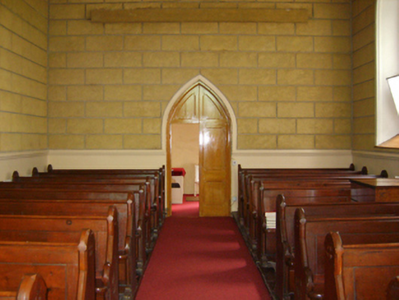Survey Data
Reg No
15702546
Rating
Regional
Categories of Special Interest
Architectural, Artistic, Historical, Social
Previous Name
Saint Busk's Church (Templescoby)
Original Use
Church/chapel
In Use As
Church/chapel
Date
1815 - 1820
Coordinates
294577, 139275
Date Recorded
21/08/2007
Date Updated
--/--/--
Description
Detached three-bay double-height single-cell Board of First Fruits Church of Ireland church, completed 1817; consecrated 1818, on a rectangular plan with single-bay three-stage tower to entrance (north) front on a square plan. Pitched slate roof with clay ridge tiles, cut-granite coping to gables including moss-covered cut-granite coping to gable (south) on cut-granite diagonal obelisk pinnacle-topped kneelers with cut-granite diagonal obelisk pinnacle to apex, and cast-iron rainwater goods on cut-granite eaves retaining cast-iron octagonal or ogee hoppers and downpipes. Roughcast walls with rusticated cut-granite quoins to corners; slate hung surface finish (south); rendered, ruled and lined surface finish (tower) with rusticated cut-granite quoins (first stage) or granite ashlar piers (upper stages) to corners including "arrow loop"-detailed battlemented piers (bell stage) framing "arrow loop"-detailed crow stepped battlements having cut-granite "saddleback" coping. Pointed-arch window openings with cut-granite sills, timber Y-mullions, and concealed dressings framing six-over-six timber sash windows without horns having Y-tracery glazing bars. Pointed-arch window opening (south) with cut-granite sill, timber interlocking Y-mullions, and concealed dressings framing six-over-six timber sash windows without horns having Y-tracery glazing bars. Lancet blind opening (tower) with cut-granite sill, and concealed dressings framing rendered, ruled and lined infill. Square-headed blind openings (second stage) with cut-granite sills, and concealed dressings with hood mouldings over framing rendered, ruled and lined infill. Lancet openings (bell stage) with cut-granite sills, and concealed dressings with hood mouldings framing louvered fittings. Interior including vestibule (north); pointed-arch door opening into nave with timber panelled double doors having overpanel; full-height interior with carpeted central aisle between quatrefoil-detailed timber pews, carved timber dado rail, cut-white marble Gothic-style wall monument (1854) with polished brass Gothic-style wall monument (1876), quatrefoil-perforated Gothic-style pulpit on an octagonal plan with Gothic-style clerk's desk, carpeted cut-veined white marble stepped dais to chancel (south) with wrought iron-detailed barley-twist balusters supporting carved timber communion railing centred on cloaked altar table below "South Window", and moulded plasterwork cornice to ceiling. Set in landscaped grounds with rendered, ruled and lined piers to perimeter having cut-granite shallow pyramidal capping supporting wrought iron double gates.
Appraisal
A church erected with financial support from the Board of First Fruits (fl. 1711-1833) representing an important component of the early nineteenth-century built heritage of County Wexford with the architectural value of the composition, one originally dedicated to the apocryphal Saint Busk (Leslie 1936, 243), confirmed by such attributes as the standardised nave-with-entrance tower plan form, aligned along a liturgically-incorrect axis; the "pointed" profile of the openings underpinning a contemporary Georgian Gothic theme with the chancel defined by an elegant "South Window"; and the "toy fortifications" embellishing the tower as a picturesque eye-catcher in the landscape. Having been well maintained, the elementary form and massing survive intact together with substantial quantities of the original fabric, both to the exterior and to the interior, including a partial slate hung surface finish widely regarded as an increasingly endangered hallmark of the architectural heritage of County Wexford: meanwhile, contemporary joinery; wall monuments commemorating Lorenzo John Walters (1810-54) of Clohass (see 15702545) and William Henry Farmar (1831-76) of Bloomfield (see 15702548); and sleek plasterwork refinements, all highlight the artistic potential of a church forming part of a self-contained group alongside the adjacent Adelaide School (see 15702547) with the resulting ecclesiastical ensemble making a pleasing visual statement 'very well sited in a group of trees' (Craig and Garner 1975, 614).







